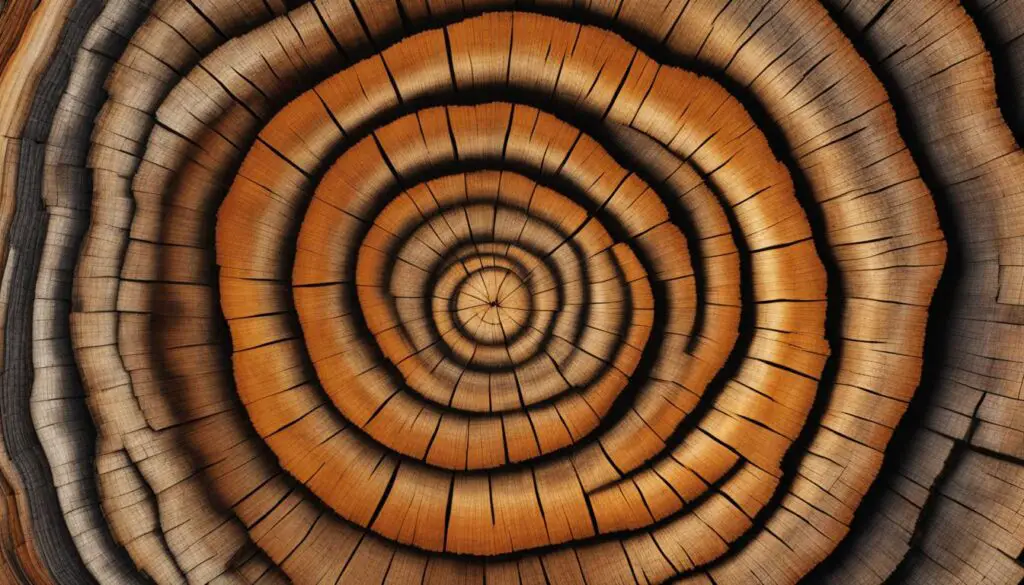Pine trees are known for their majestic beauty and significant presence in natural landscapes. But have you ever wondered how these magnificent trees grow and develop? Understanding the growth stages and life cycle of pine trees is essential for their care and maintenance. In this article, we will delve into the fascinating world of pine tree growth, exploring the stages, factors that influence it, and the importance of proper pruning and care.
Key Takeaways:
- Pine trees go through various stages of growth throughout their life cycle.
- Factors such as root system, soil type, sunlight, and climate conditions affect pine tree growth.
- Proper pruning techniques can enhance the tree’s beauty and promote future growth.
- Tree rings provide valuable insights into a pine tree’s growth patterns and environmental history.
- Providing adequate water, sunlight, and nutrients is crucial for the health and optimal growth of pine trees.
Factors that Affect Pine Tree Growth
When it comes to the growth of pine trees, several factors come into play. One of the most crucial factors is the root system. Pine trees boast a deep and robust root system that not only anchors the tree firmly in the ground but also serves as a source of vital nutrients and water. This extensive network of roots allows the tree to absorb essential elements necessary for its growth and overall health.
The type of soil in which the pine tree is planted also influences its growth. Well-draining soil with a balanced composition of nutrients provides an ideal environment for the tree’s roots to develop and thrive. Additionally, an ample supply of sunlight plays a vital role in the growth of pine trees. Sunlight acts as a catalyst for photosynthesis, the process through which trees convert light energy into chemical energy, allowing them to grow and flourish.
Climate Conditions and Growth
The climate conditions in the area where pine trees are cultivated significantly impact their growth. Adequate moisture and a longer growing season contribute to healthy growth, as the tree has ample time to absorb water and sunlight, fostering the development of sturdy branches and lush foliage. Conversely, drought and severe winters can hinder the growth of pine trees, leading to stunted development and a weakened root system. Therefore, it is important to consider these climate factors when planning to grow and care for pine trees.
To create optimal conditions for the growth of pine trees, it is essential to understand the various factors that influence their development. By ensuring a deep and healthy root system, providing suitable soil, ample sunlight, and favorable climate conditions, you can help pine trees reach their full potential and thrive in their environment.
The Pine Tree Life Cycle
The life cycle of a pine tree is a fascinating process that encompasses various stages of growth and development. Understanding this life cycle can provide valuable insights into caring for and growing pine trees successfully.
The life cycle of a pine tree begins with a seedling taking root in the ground. As the seedling grows, it develops into a young tree, establishing a strong foundation for future growth. During this stage, the tree undergoes significant changes, both above and below the ground, as it develops a robust root system and begins to sprout branches.
As the young tree continues to mature, it enters its reproductive phase and starts producing cones. These cones house the tree’s seeds, which can be dispersed by wind or animals to continue the cycle of growth. With time, the pine tree reaches its full size and becomes a majestic presence in the landscape.
Pine trees have an impressive lifespan, with some species living for several hundred years. This longevity is a testament to their resilience and adaptability. To ensure the successful growth and longevity of pine trees, proper care is essential.
Tips for Growing Pine Trees:
- Provide sufficient water: Pine trees thrive in moist soil, so regular watering is crucial, especially during dry periods. Adequate hydration promotes healthy growth and helps the tree withstand stress.
- Ensure adequate sunlight: Position your pine tree in an area with ample sunlight to support photosynthesis, a vital process for tree growth. However, be mindful of excessive heat and scorching sun rays, as they can damage the tree.
- Supply essential nutrients: Fertilize your pine tree with a balanced fertilizer specifically formulated for conifers. This provides the necessary nutrients for optimal growth and vigor.
- Regular pruning and maintenance:
Proper pruning is essential to maintain the health and shape of a pine tree. Remove any dead, damaged, or overcrowded branches to enhance airflow and sunlight penetration. Pruning also helps shape the tree and encourages new growth.

| Stage | Description |
|---|---|
| Seedling | The beginning stage where a pine tree takes root and starts to grow. |
| Youth | The stage where the tree develops and establishes its root system and branches. |
| Maturation | The reproductive phase where the tree produces cones and reaches its full size. |
| Maturity | The tree reaches its full size and becomes a prominent presence in the landscape. |
By following these tips and understanding the life cycle of pine trees, you can create an optimal environment for their growth and ensure their longevity. With proper care, your pine trees will thrive, providing beauty, shade, and numerous other benefits for years to come.
Pruning Pine Trees for Optimal Growth
Pruning is a crucial aspect of pine tree care to promote optimal growth. By employing proper pruning techniques, you can enhance the health and beauty of your pine trees. Here are some important pine tree care tips:
- Spring Candling: This technique involves the removal of new growth, known as candles, to control the length and density of branches. By selectively pruning candles, you can maintain the desired shape of the tree and promote balanced growth.
- Winter Needling: Removing needles during winter helps reveal the tree’s natural shape and structure. By allowing light and air to penetrate the center and lower branches, you create favorable conditions for healthy growth.
- Branch Removal: Pruning out dead, damaged, or overcrowded branches is essential for maintaining tree health and promoting optimal growth. Removing these branches allows the tree to allocate its energy efficiently and focus on new growth.
Proper pruning directs the energy flow of the tree, shapes its form, and creates favorable conditions for future growth. By following these pine tree care tips, you can ensure the longevity and vitality of your pine trees.
“Proper pruning directs the energy flow of the tree, shapes its form, and creates favorable conditions for future growth.”
Understanding Tree Rings and Growth Patterns
Tree rings offer a fascinating glimpse into the growth and environmental history of trees. Each year, a tree adds a new growth ring, visible as a ring in the cross-section of its trunk. These rings serve as records, capturing evidence of various climatic conditions and events that the tree has experienced throughout its lifespan.
Tree rings can reveal valuable information about floods, insect attacks, droughts, wildfires, and even earthquakes that occurred during the tree’s growth. By studying these tree rings, scientists can employ a discipline called dendrochronology to determine the precise age of a tree, reconstruct past climates, and analyze patterns of growth.

Dendrochronology enables researchers to compare patterns observed in tree rings with known historical data, creating a valuable tool for understanding past environmental changes. This method also provides insights into the growth patterns of pine trees and other tree species over time.
The study of tree rings not only allows us to understand the past but also provides valuable information for predicting and managing future changes in our ecosystems. By analyzing tree growth patterns, scientists can gain insights into the health and resilience of forest ecosystems, helping us make informed decisions about conservation and land management.
Conclusion
Planting and caring for pine trees requires a comprehensive understanding of their growth stages, the factors that influence their growth, and the proper care techniques. By providing essential elements such as water, sunlight, and nutrients, and implementing effective pruning methods, you can ensure the health and optimal growth of pine trees.
Furthermore, studying tree rings through the science of dendrochronology offers valuable insights into the past climate conditions and growth patterns of pine trees. This information can help you make informed decisions about the care and maintenance of your trees.
With the right knowledge and care, you can enjoy the beauty and multiple benefits that pine trees bring to diverse environments. Whether you’re planting them for aesthetic purposes, to create shade, or to support the ecosystem, following a pine tree planting guide and applying proper care techniques will help your trees thrive for years to come.
FAQ
How do pine trees grow?
Pine trees go through various stages of growth throughout their life cycle, starting from seedlings and eventually reaching their full size. Adequate water, sunlight, and nutrients are essential for their growth.
What are the growth stages of pine trees?
Pine trees start as seedlings, grow into young trees, and eventually reach their full size. As the tree ages, interior and low branches die off due to lack of light and energy.
What factors affect pine tree growth?
The growth of pine trees is influenced by factors such as the root system, soil type, availability of sunlight, and climate conditions. Adequate moisture and a long growing season contribute to healthy growth, while drought and severe winters can hinder growth.
How can I care for pine trees?
To care for pine trees, provide sufficient water, adequate sunlight, and nutrients. Regular pruning is necessary to maintain the tree’s health and shape. Pruning techniques include spring candling, winter needling, and branch removal.
What are tree rings, and what do they reveal about pine tree growth?
Tree rings are annual growth rings visible in the cross-section of a tree trunk. They record evidence of climatic conditions and events that occurred during the tree’s lifespan. The study of tree rings, called dendrochronology, can provide insights into past climates and growth patterns.
How can dendrochronology be used to study pine tree growth?
Dendrochronology, the study of tree rings, can be used to determine precise ages of trees, reconstruct past climates, and analyze patterns of growth. By studying tree rings, scientists can gain insights into the history and growth patterns of pine trees.
What should I consider when planting pine trees?
When planting pine trees, consider the specific care requirements of the species and ensure they are planted in well-draining soil. Provide adequate water, sunlight, and nutrients for optimal growth.

